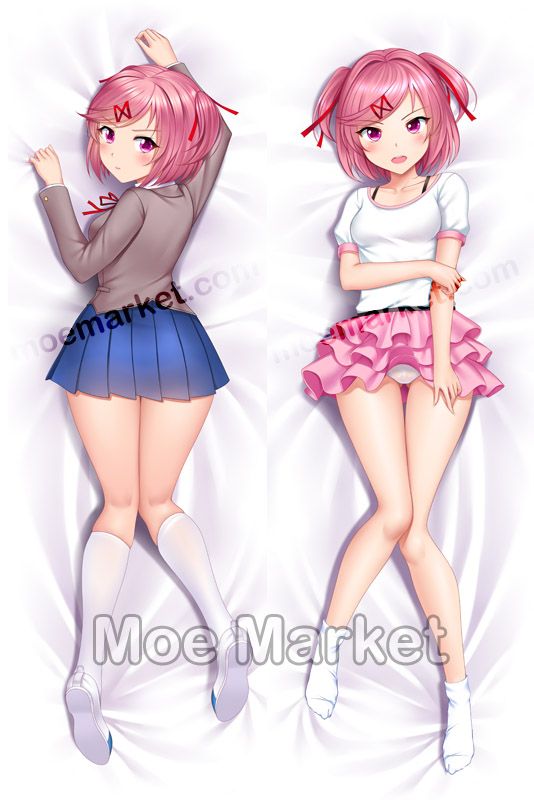Doki Doki Literature Club features four cutely stylized anime girls, each of which is based on a typical anime personality trope. There’s Yuri, the yandere, a quiet and intense bookworm who quickly grows obsessive and violent due to her love for the main character. There’s Natsuki, the tsundere, a younger girl who masks her sweet inner nature with hostility and rudeness. There’s Sayori, the deredere, an energetic girl-next-door type who makes everyone around her happy. Finally, there’s Monika. Monika is a bit harder to describe, but she is overall a popular and well-liked leader within the game’s high school setting.

These four tropes have long been staples of anime, and though they vary, they all share elements of innocence or cuteness, and all of their main personality traits are defined in relation to their interactions with male characters (often in a romantic way). Because these tropes deal so significantly with desirability to men, many of the anime girls that fall into these tropes have become objects of fetishization and obsession for male fans, often to a startling degree.
The goal of DDLC is to completely subvert these expectations and deconstruct these tropes. Underneath the cute and easily-recognizable illustration style is an intense darkness that destabilizes every aspect of the game as well as player experience. Yuri’s yandere tendencies veer into compulsive self-harm that leads to her death. Natsuki’s tough exterior is a coping mechanism for her father’s constant abuse. Sayori’s constant cheeriness masks her deep struggles with clinical depression, a struggle which she is unable to overcome when her story ends in suicide. And Monika is actually “aware” of her status as a video game character and is willing to do whatever it takes to escape the game’s confines. Even if the main character confesses his love to the characters, he cannot save them from death. By decentering the role of the main character and revealing the complex and dark inner worlds that are responsible for the outward appearance of the innocent anime girl trope, DDLC effectively forces the player to question their assumptions about the dating sim, their relationship to the dateable female characters, and their conception of these tropes.

DDLC is so effective, in fact, that its release was met with internet vitality and huge acclaim. And as with most games that goes viral, Doki Doki quickly generated an enormous fandom. While much of the fandom appreciated the game’s intelligent design and identified with the characters’ mental health struggles, a darker side emerged. Despite one of the core messages of the game being to be critical of the romanticization and fetishization of anime girls and tropes, many members of the fandom repeat these same problematic behaviors with the Doki Doki girls. Fans buy questionable merchandise like body pillows, talk about and evaluate the appearance of each character, and even create suggestive or explicit fan art.
Obviously the creator of DDLC has no control over how fans react, and nearly every piece of media has fans that cross a line. However, these fans’ obsession with the Doki Doki girls reveals some of the potential limits of the game’s medium. The creators used the standard, cutesy visual novel/anime style in order to set up the player’s expectations in a specific way to then subvert them. But in using this style, they also made the characters subject to inappropriate obsession. Though the characters may not act like typical anime girls, their visual design aligns them with a category that is inextricable from the male fantasy, and was therefore quick to attract a specific type of fanbase.

I don’t think that the actions of the fandom negate Doki Doki Literature Club‘s brilliance or effectiveness as a game. However, since a game’s core trait is interactivity, it is also clear that the actions of its players are not irrelevant. My aim with these observations is not necessarily to criticize DDLC, but to raise some important questions regarding game design. Is there a way for a game to subvert generic expectations without being inhibited by the form of the genre it attempts to subvert? Can a visual style or other specific medium-based aspects ever be free from their sociocultural contexts?

The unfortunate side effect of using a dating sim to deconstruct typical dating sim tropes is that the internet is insanely horny, and does not always look at games with a critical eye. Despite our examination of Doki Doki Literature Club as a metagame, many people view Doki Doki Literature Club as a dating sim with psychological horror elements (or maybe a horror game with dating sim elements). The game is marketed as a horror dating sim hybrid, not a metagame. The Plus edition of the game adds more cutesey dating sim content, further cementing it as a horror dating sim. Despite its large focus on metagame elements, it’s difficult for a casual fan to interpret it as such. This marketing is probably a big reason as to why the fandom around DDLC focused in on the romance aspect of the game in their fan creations. Lots of the character art in DDLC is reminiscent of other visual novels where the main point was to end up with a girl. Sayori’s closet character art comes to mind in particular as one with a lot of sexual subtext. Playing the game blind leads to many players leaning into these dating sim tropes, not realizing the commentary behind it. Perhaps with different marketing, the game would have been interpreted differently, but I think at this point, the context of its genre is too ingrained with DDLC to change that.